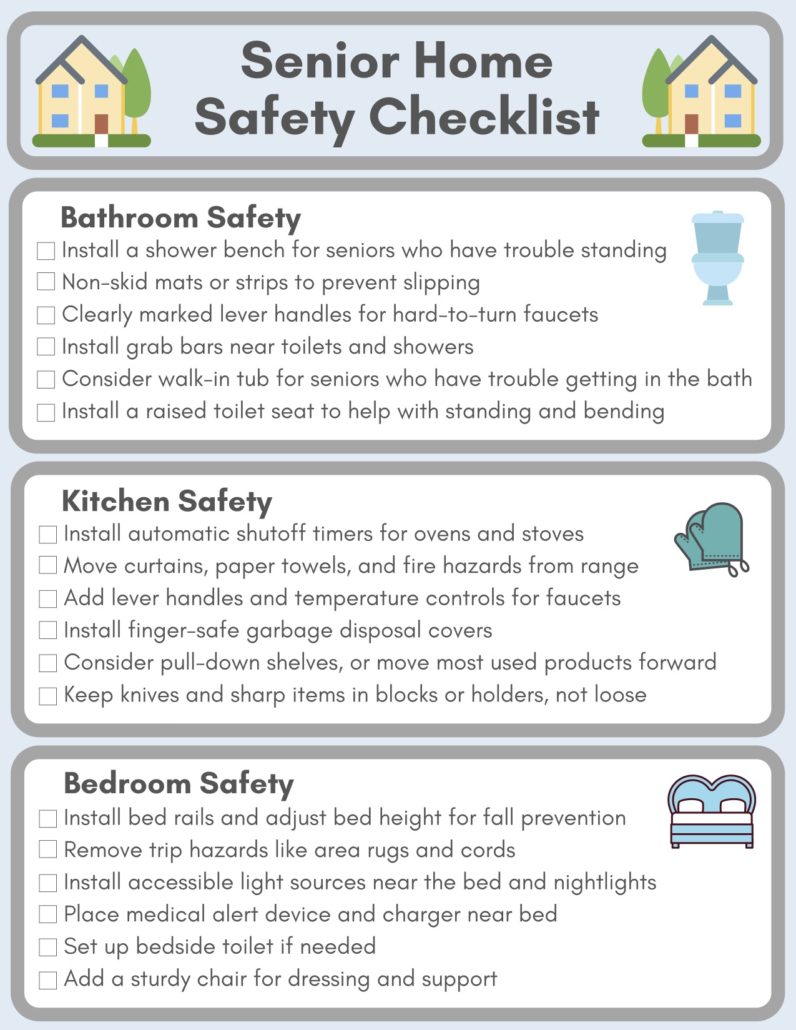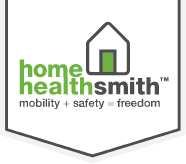Home Safety Tips for Seniors Aging in Place
Originally published on www.aplaceformom.com by Zach Russell.
These steps, sometimes combined with home care services, can help seniors age in place longer.
Nearly 90% of homeowners approaching retirement want to stay in their homes as they age, according to a study by the Federal Housing Administration. To prevent injuries, reduce fall risks, and ensure independence, it’s important for families and seniors to take home safety precautions. These steps, sometimes combined with home care services, can help seniors age in place longer.
Take steps toward fall prevention
Falls are the leading cause of fatal and nonfatal injuries in seniors 65 and older, according to the Centers for Disease Control and Prevention (CDC). With aging skin and decreased bone density, seniors often have difficulty recovering from falls — both physically and financially.
In fact, each prevented fall saves an average of $30,000 in hospital and rehabilitation costs, according to Fritzi Gros-Daillon, director of education and advocacy at Age Safe America.
Take these steps to reduce fall risk:
- Remove trip hazards
Area rugs, electrical cords, and low tables and ottomans are all risks. If there’s a pet or child in the home, be sure to keep toys picked up. Install non-slip flooring, and cover all cords and wires. - Install bathroom grab bars
Most in-home falls occur in the bathroom, says Gros-Daillon. Age Safe America calls falls “a preventable epidemic” and began a “Grab Bars are the New Seatbelts” campaign last year. Grab bars can be purchased at hardware stores and installed by handy do-it-yourselfers, plumbers, or home safety specialists. - Provide easy seating
Make the home senior friendly by adding accessible seating, like a bench near the front door for putting on shoes. Kitchen and shower stools make it easier for seniors to perform activities of daily living, like cooking and bathing independently. - Check thresholds
“Making thresholds easier to cross is one of the first things you should do to help keep seniors safe,” says Linda Bohmbach, co-founder and vice president of sales and marketing at Home Healthsmith, a home safety modification company in Portsmouth, Rhode Island. Raised flooring between rooms can be a significant trip hazard. Ask a safety expert about flattening thresholds or adding indoor ramps or handrails. - Don’t forget outdoor spaces
Check the driveway for cracks regularly, and be sure there’s a clear path to the mailbox. Remove trip hazards like rocks and roots from the yard.
Technology and medical alert devices improve senior safety
Even if your aging relative isn’t tech-savvy, these simple and easy-to-use devices can help reduce fall risks, manage medication, and access help in case of emergency:
- Medical alert devices help seniors in distress. Wearable devices, like LifeAlert or Bay Alarm Medical, have easy-access buttons to call for emergency assistance and can be connected to landlines or cellular service. Some companies, such as Life Station and Medical Alert, provide fall detection for an additional fee.
- Senior-friendly cell phones help older adults stay connected with friends and family, and they make emergency help more accessible in case of an accident. Some phones, like the GreatCall Jitterbug and the Consumer Cellular GrandPad, come with built-in emergency networks and GPS tracking.
- Smart home devices “are a good way to help seniors get accustomed to technology,” says Bohmbach. “Even ones who don’t want to use tech can benefit from reminders and services.” You can use smart devices to set medication reminders, make landline-to-landline emergency calls, and access entertainment like audiobooks and music.
- GPS tracking devices are one way for caregivers and families to prevent the dangers of wandering in senior loved ones with dementia or memory loss.
- Telehealth services provide seniors access to doctors and nurses without leaving the comfort of their homes. “We selected Electronic Caregiver based upon their strong customer support, 24/7 emergency response services, easily implementable systems, and advanced remote patient monitoring,” says Gros-Daillon.
Security and maintenance help with senior safety
Home maintenance is key for seniors aging in place. Create a home safety checklist (including the tasks below) to review monthly, and suggest home safety assessments annually. You can also use the home safety checklist A Place for Mom has provided.
- Check carbon monoxide and smoke alarms at least once a month
- Note expiration dates on fire extinguishers and replace when necessary. If your aging relative smokes or requires flammable oxygen, place fire extinguishers in all common rooms
- Inspect towel racks, bath mats, and handles to make sure they’re secure
- Check for burnt-out lightbulbs. Poorly lit spaces can lead to falls. If possible, install smart lights or motion sensors with bulb alerts
- Make sure laundry lint traps are cleaned and there aren’t any leaks in home appliances
- Check for trash. Sometimes, elderly people become unable to carry heavy trash bags or unclog toilets on their own. If you notice a smell, look for signs of hoarding or excess waste
- Install alarms or work with a professional security company. Also, be sure your aging relative can work their locks properly. Seniors can be targets of break-ins and theft, so preventive measures are key

Home safety for seniors with dementia
Seniors with mild cognitive impairment may be able to age at home, but those who have begun to wander or have experienced significant memory loss should be supervised at all times. If you’re caring for a senior loved one with dementia in your own home, take these extra safety precautions:
- Use appliances with auto-shutoff features, or install hidden gas valves and circuit breakers, so that ovens, fire places, and stoves can’t be left on
- Put finger guards on garbage disposals or cover switches with safety locks
- Lock all drawers and cabinets containing knives, cleaning supplies, and medication. Also secure garages or basements that may contain harmful chemicals or machinery.
- Make sure locks installed to exterior doors are out of sight (either high or low), or use deadbolts to prevent wandering outside the house
- Remove locks from the senior’s bedroom and bathroom, so they can’t accidentally lock themselves in and start to panic.
- Install easily accessible lights and night lights throughout the home to reduce disorientation at night
- Create clear paths and open areas
This helps to encourage independence and social interaction, which are two important needs for people with dementia, according to Alzheimer’s Association.
Be proactive with senior safety
Often, elderly people don’t realize their home is unsafe and don’t feel the need to make changes, says Bohmbach. About half of those who request home safety inspections are seniors, and the other half are concerned relatives.
To ensure home safety for seniors, it’s best to start preparing before an emergency or life-changing event. Proper precautions can reduce fall risk, and fewer injuries make it easier for seniors to age at home.
“We believe that more people are getting the message about being proactive, but it’s a challenge,” says Gros-Daillon. “The consequences of a fall, like a trip to the ER, are more likely to be a motivator these days.”
By starting small with simpler additions — like grab bars, non-slip mats, and accessible light switches and door handles — you may be able to reduce the need for more significant and expensive renovations. A certified home safety specialist can help prioritize steps to keep your senior loved one safe in their home.
Schedule a home safety inspection
An initial inspection is a vital first step, as an expert can notice risk factors a family member may not recognize.
“We start our safety audit at the driveway and work our way in to determine any potential hazards that may put you at risk,” says Bohmbach.
A thorough home safety inspection should include:
- An assessment of “red zones,” like bathrooms, kitchens, staircases, porches, and outdoor steps
- A search for existing fall hazards
- A check for fire hazards and working alarms
- Information about door widening, stair lifts, wheelchair ramps, and any other appropriate accessibility or safety additions
A comprehensive proposal including pricing
Any home is adaptable for elderly safety
If your senior loved one is set on aging at home, accessibility devices can help. Chair lifts can be installed in multistory houses, and ramps can replace exterior steps.
Bohmbach notes that any home can be made senior-friendly with the right modifications, and that seniors deserve to feel independent in the houses they love.
“When they look in the mirror, they don’t see someone who’s older,” she says. “They see someone about to go off to war, or a businessman or a homemaker, so we make the modifications to help them live a full and independent life at home.”
Whether it’s small fixes like moving electric outlets to accessible locations and replacing doorknobs with lever handles, or bigger renovations like adding an elevator, home safety experts can help allow your senior loved one to age in place.
Home health care for seniors aging in place
While accessibility devices and routine safety checks can help with home safety, assistance with health care and activities of daily living may become necessary as seniors age. Home care and home health are valuable resources for seniors aging in place.
Get in touch with A Place for Mom’s local Senior Living Advisors to find out more about home care in your area.


